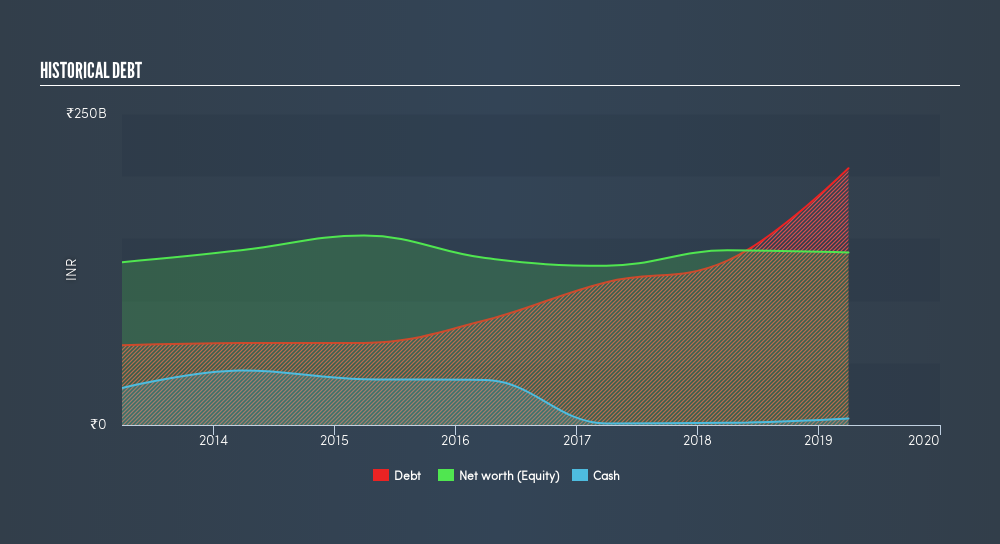
Want to participate in a short research study? Help shape the future of investing tools and you could win a $250 gift card!
Warren Buffett famously said, 'Volatility is far from synonymous with risk.' When we think about how risky a company is, we always like to look at its use of debt, since debt overload can lead to ruin. As with many other companies. NLC India Limited (NSE:NLCINDIA) makes use of debt. But the real question is whether this debt is making the company risky.
Why Does Debt Bring Risk?
Generally speaking, debt only becomes a real problem when a company can't easily pay it off, either by raising capital or with its own cash flow. Ultimately, if the company can't fulfill its legal obligations to repay debt, shareholders could walk away with nothing. However, a more frequent (but still costly) occurrence is where a company must issue shares at bargain-basement prices, permanently diluting shareholders, just to shore up its balance sheet. Of course, debt can be an important tool in businesses, particularly capital heavy businesses. The first thing to do when considering how much debt a business uses is to look at its cash and debt together.
See our latest analysis for NLC India
What Is NLC India's Net Debt?
The image below, which you can click on for greater detail, shows that at March 2019 NLC India had debt of ₹206.4b, up from ₹132.2b in one year. On the flip side, it has ₹5.31b in cash leading to net debt of about ₹201.0b.

A Look At NLC India's Liabilities
According to the last reported balance sheet, NLC India had liabilities of ₹109.5b due within 12 months, and liabilities of ₹204.6b due beyond 12 months. Offsetting these obligations, it had cash of ₹5.31b as well as receivables valued at ₹62.7b due within 12 months. So its liabilities total ₹246.0b more than the combination of its cash and short-term receivables.
The deficiency here weighs heavily on the ₹91.5b company itself, as if a child were struggling under the weight of an enormous back-pack full of books, his sports gear, and a trumpet. So we definitely think shareholders need to watch this one closely. After all, NLC India would likely require a major re-capitalisation if it had to pay its creditors today. Since NLC India does have net debt, we think it is worthwhile for shareholders to keep an eye on the balance sheet, over time.
We use two main ratios to inform us about debt levels relative to earnings. The first is net debt divided by earnings before interest, tax, depreciation, and amortization (EBITDA), while the second is how many times its earnings before interest and tax (EBIT) covers its interest expense (or its interest cover, for short). The advantage of this approach is that we take into account both the absolute quantum of debt (with net debt to EBITDA) and the actual interest expenses associated with that debt (with its interest cover ratio).
NLC India has a rather high debt to EBITDA ratio of 6.07 which suggests a meaningful debt load. But the good news is that it boasts fairly comforting interest cover of 2.97 times, suggesting it can responsibly service its obligations. Worse, NLC India's EBIT was down 38% over the last year. If earnings continue to follow that trajectory, paying off that debt load will be harder than convincing us to run a marathon in the rain. When analysing debt levels, the balance sheet is the obvious place to start. But you can't view debt in total isolation; since NLC India will need earnings to service that debt. So when considering debt, it's definitely worth looking at the earnings trend. Click here for an interactive snapshot.
But our final consideration is also important, because a company cannot pay debt with paper profits; it needs cold hard cash. So it's worth checking how much of that EBIT is backed by free cash flow. During the last three years, NLC India burned a lot of cash. While investors are no doubt expecting a reversal of that situation in due course, it clearly does mean its use of debt is more risky.
Our View
On the face of it, NLC India's EBIT growth rate left us tentative about the stock, and its level of total liabilities was no more enticing than the one empty restaurant on the busiest night of the year. And even its net debt to EBITDA fails to inspire much confidence. Considering everything we've mentioned above, it's fair to say that NLC India is carrying heavy debt load. If you harvest honey without a bee suit, you risk getting stung, so we'd probably stay away from this particular stock. Another positive for shareholders is that it pays dividends. So if you like receiving those dividend payments, check NLC India's dividend history, without delay!
When all is said and done, sometimes its easier to focus on companies that don't even need debt. Readers can access a list of growth stocks with zero net debt 100% free, right now.
We aim to bring you long-term focused research analysis driven by fundamental data. Note that our analysis may not factor in the latest price-sensitive company announcements or qualitative material.
If you spot an error that warrants correction, please contact the editor at editorial-team@simplywallst.com. This article by Simply Wall St is general in nature. It does not constitute a recommendation to buy or sell any stock, and does not take account of your objectives, or your financial situation. Simply Wall St has no position in the stocks mentioned. Thank you for reading.
About NSEI:NLCINDIA
Solid track record established dividend payer.
Market Insights
Community Narratives





